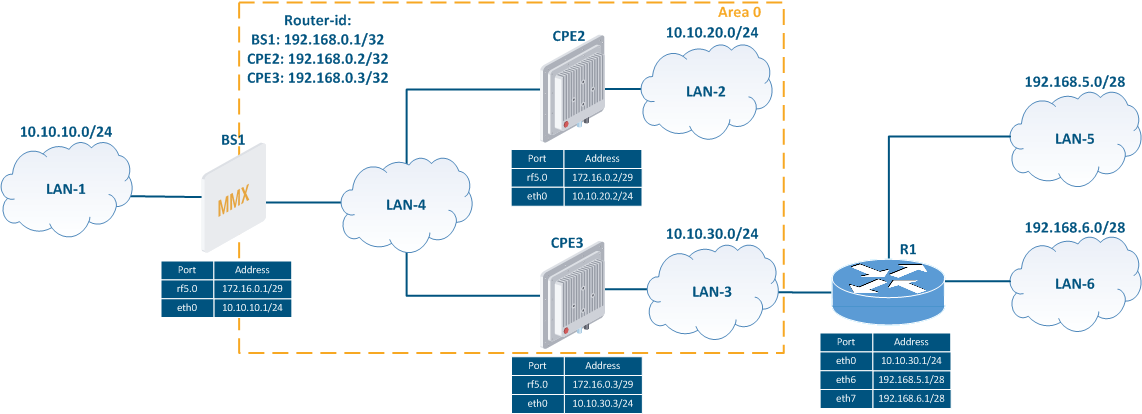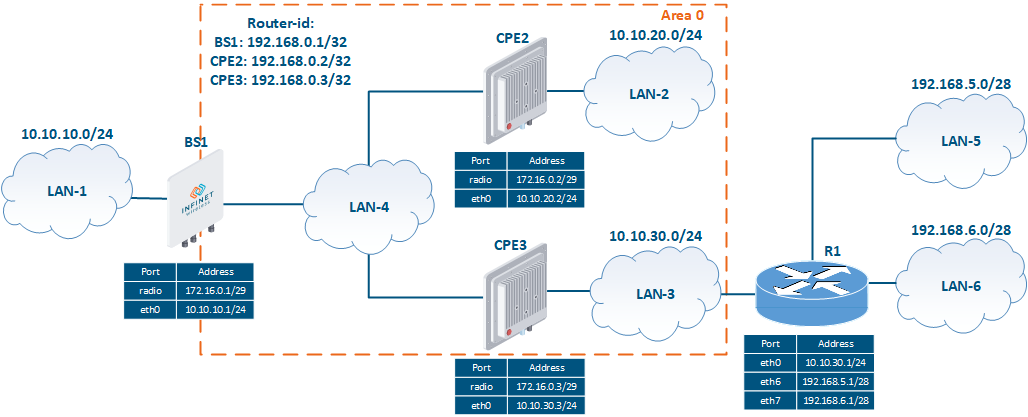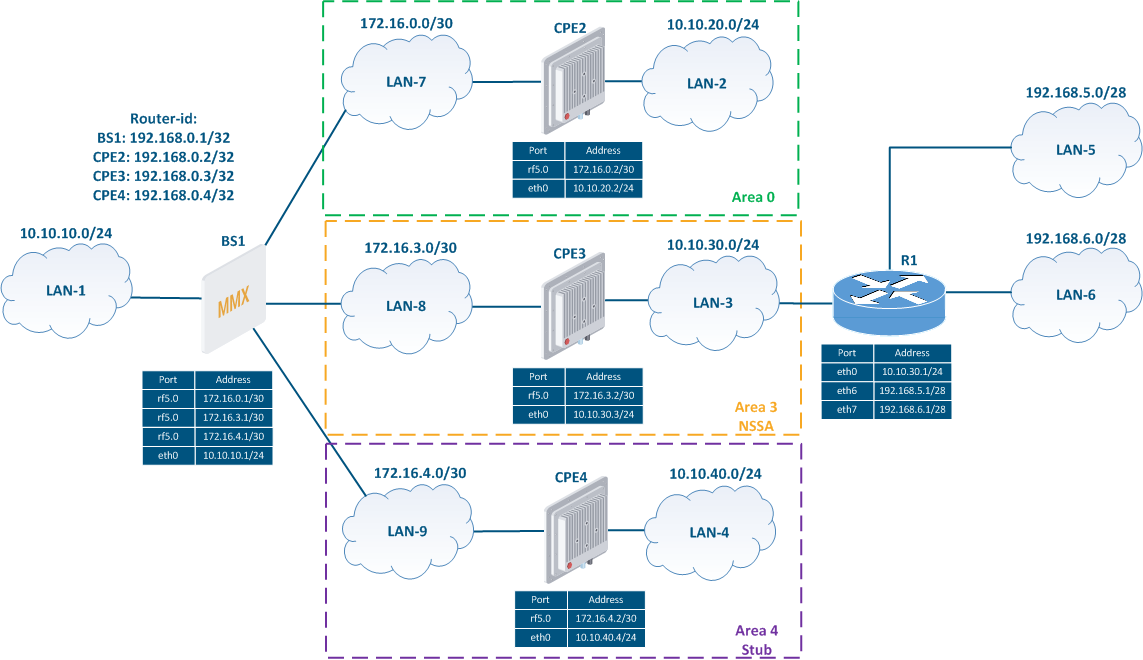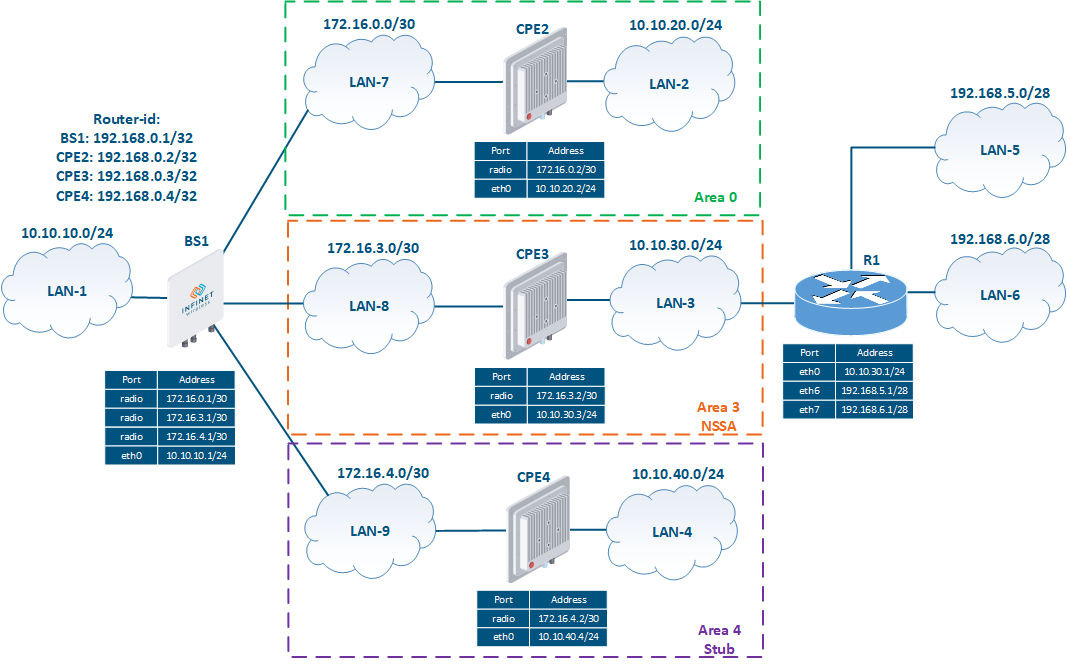...
The OSPF configuration is performed only via CLI. A separate command shell with several modes is used to configure the OSPF protocol (Figure 1). The transition to each mode is performed using commands having the same name as the mode. A detailed description of the commands is available in the Technical documentation.
| Note | ||
|---|---|---|
| ||
An configuration example is given for the InfiLINK 2x2, InfiMAN 2x2 families devices, pay attention to the name of the radio interface on your devices during the scheme implementation. |
| Mode name | Description | |||||||
|---|---|---|---|---|---|---|---|---|
| Basic | The basic OSPF mode is used to analyze the output of the diagnostic commands and to switch to the configuration mode. Switching to the basic mode is performed from the WANFleX command shell using the "ospf" command.
| |||||||
| OSPF configuration | The configuration mode allows to manage the OSPF service running on the device and to proceed to the additional configuration modes: router, interfaces or route-maps. The switching to the OSPF configuration mode is performed from the basic mode using the "config" command.
| |||||||
| OSPF router configuration | In the router configuration mode, the basic OSPF settings can be performed. This mode allows to configure the networks, the areas, the router ID, etc. The switching to the OSPF router configuration mode is performed from the configuration mode using the "router" command.
| |||||||
| OSPF interface configuration | The OSPF interface configuration mode allows to configure the protocol settings related to a specific interface. The switching to the OSPF interface configuration mode is performed from the configuration mode using the "interface IFNAME" command.
| |||||||
| Route-maps configuration | The route-maps configuration mode allows to configure the rules that should be applied to the announced or received OSPF routes. The switching to the OSPF route-map configuration mode is performed from the configuration mode using the rule creation command "route-map WORD (deny|permit) <1-65535>".
|
| Center | ||||||||
|---|---|---|---|---|---|---|---|---|
|
...
- The network consists of three wireless devices BS1, CPE2 and CPE3 configured as routers.
- The wireless devices are part of the OSPF backbone area 0 (only one OSPF area is present in this setup).
- BS1 has an external link for connecting to the LAN-1 network.
- The CPE3 router is connected to the external router R1.To make R1's router networks available, static routes to the networks 192.168.5.0/28 and 192.168.6.0/28 have been added to CPE3.
- Routers BS1, CPE2 and CPE3 use as identifiers the addresses assigned to the loopback interface: 192.168.0.1/32, 192.168.0.2/32 and 192.168.0.3/32.
| Center |
|---|
Figure 2 - Network scheme with one OSPF area |
...
- The network consists of four wireless devices BS1, CPE2, CPE3 and CPE4, configured in the router mode.
- The wireless devices are part of three OSPF areas:
- area 0: routers BS1 and CPE2 are connected to this area. The BS1 router has an external network connection;
- area 3: routers BS1 and CPE3 are connected to this area, the area's type is NSSA. The CPE3 router has an external link with router R1 and two static routes to the networks 192.168.5.0/28 and 192.168.6.0/28;
- area 4: routers BS1 and CPE4 are connected to this area, the area's type is Stub.
- Routers BS1, CPE2, CPE3 and CPE4 use the addresses assigned to the loopback interface as identifiers: 192.168.0.1/32, 192.168.0.2/32, 192.168.0.3/32 and 192.168.0.4/32.
| Center |
|---|
Figure 3 - Network scheme with several OSPF areas |
...



